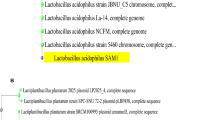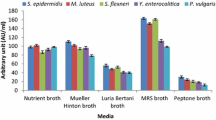Abstract
Ten strains of Lactobacillus (Lb). casei, Lb. rhamnosus, Lb. plantarum, Lb. paracasei and Lb. curvatus species were chosen to determine the production of organic acids after cultivation in skimmed milk, MRS broth and Jerusalem artichoke (JA) medium. The highest acidity was obtained in MRS broth and the weakest acidification was found in skimmed milk. Lb. casei Shirota produced the highest amount and Lb. rhamnosus VT1 the lowest amount of substances being estimated as titratable acidity. All strains produced lactic acid in the investigated broth and most of the strains produced acetic acid in MRS broth except Lb. curvatus 2768 and Lb. casei Shirota, in JA broth except Lb. paracasei SF1 and in skimmed milk except Lb. casei 2750, Lb. curvatus 2768, Lb. curvatus 2775 and Lb. casei Shirota. All strains, except Lb. plantarum 01, produced butyric acid in MRS broth. Beside the lactic and acetic acids, formic, citric, succinic and glutamic acids were also produced in MRS broth; formic and succinic acids were produced in skimmed milk and succinic acid in JA broth. Some strains showed change in their fermentation profile from homofermentative to mix-acid fermentation in milk. The antifungal efficiency of the lactic and acetic acid in the amount produced by lactobacilli was investigated. None of the investigated aspergilli were inhibited. The inhibitory effect of acids against Fusarium increased unequivocally with the increasing concentration. The study pointed at the dissimilarity of organic acid production of Lactobacillus strains, which was considerably influenced by the media.





Similar content being viewed by others
References
Holzapfel WH, Geisen R, Schillinger U (1995) Biological preservation of foods with reference to protective cultures, bacteriocins and food-grade enzymes. Int J Food Microbiol 24:343–362
Ross RP, Morgan S, Hill C (2002) Preservation and fermentation: past, present and future. Int J Food Microbiol 79:3–16
Stiles ME (1996) Biopreservation by lactic acid bacteria. Antonie van Leeuwenhoek 70:331–345
Vermeiren L, Devlieghere F, Debevere J (2004) Evaluation of meat born lactic acid bacteria as protective cultures for the biopreservation of cooked meat products. Int J Food Microbiol 96:149–164
Stiles ME, Holzapfel WH (1997) Lactic acid bacteria of foods and their current taxonomy. Int J Food Microbiol 36:1–29
Ouwehand AC (1998) In: Salminen S, von Wright A (eds) Lactic acid bacteria: microbiology and functional aspects, 2nd edn. Marcel Dekker, New York
Corsetti A, Gobetti M, Rossi J, Daminiani P (1998) Antimould activity of sourdough lactic acid bacteria: identification of mixture of organic acids by Lactobacillus sanfrancisco CB1. Appl Microbiol Biotechnol 50:253–256
Rodrígues E, Tomillo J, Nuñez M, Medina M (1997) Combined effect of bacteriocin-producing lactic acid bacteria and lactoperoxidase system activation on Listeria monocytogenes in refrigerated milk. J Appl Environ Microbiol 83:389–395
Ito A, Sato Y, Kudo S, Sato S, Nakajima H, Toba T (2003) The screening of hydrogen peroxide-producing lactic acid bacteria and their application to inactivating psychrotrophic food-borne pathogens. Curr Microbiol 47:231–236
Ammor S, Tauveron G, Dufour E, Chevallier I (2006) Antibacterial activity of lactic acid bacteria against spoilage and pathogenic bacteria isolated from the same meat small-scale facility 1-screening and characterization of the antibacterial compounds. Food Control 17:454–461
Cleveland J, Montville TJ, Nes IF, Chikindas ML (2001) Bacteriocins: safe, natural antimicrobials for food preservation. Int J Food Microbiol 71:1–20
Plocková M, Stiles J, Chumchalová J, Halfarová R (2001) Control of mould growth by Lactobacillus rhamnosus VT1 and Lactobacillus reuteri CCM 3625 on milk agar plates. Czech J Food Sci 19:46–50
Tomás MS, Bru E, Wiese B, de Ruiz Holgado AAP, Nader-Macías ME (2002) Influence of pH, temperature and culture media on the growth and bacteriocin production by vaginal Lactobacillus salivarius CRL 1328. J Appl Microbiol 93:714–724
Avonts L, Van Uytven E, De Vuyst L (2004) Cell growth and bacteriocin production of probiotic Lactobacillus strains in different media. Int Dairy J 14:947–955
Zalán Zs, Németh E, Baráth Á, Halász A (2005) Influence of growth medium on hydrogen peroxide and bacteriocin production of Lactobacillus strains. Food Technol Biotechnol 43:219–225
Gourama H, Bullerman LB (1997) Anti-aflatoxigenic activity of Lactobacillus casei pseudoplantarum. Int J Food Microbiol 34:131–143
Božanić R, Tratnik LJ, Hruškar M (2003) Influence of culture activity on aroma components in yoghurts produced from goat’s and cow’s milk. Acta Aliment Hung 32:151–160
Taniwaki MH, Hocking AD, Pitt JI, Fleet GH (2001) Growth of fungi and mycotoxin production on cheese under modified atmospheres. Int J Food Microbiol 68:125–133
Tournas VH, Heeres J, Burgess L (2006) Moulds and yeasts in fruit salads and fruit juices. Food Microbiol 23:684–688
Caplice E, Fitzgerald GF (1999) Food fermentations: role of microorganisms in food production and preservation. Int J Food Microbiol 50:131–149
Prajapati JB, Nair BM (2003) In: Farnworth ER (ed) Handbook of fermented functional foods. CRC Press, Boca Raton
Mäyrä-Mäkinen A, Bigret M (2004) In: Salminen S, Von Wright A, Ouwehand A (eds) Lactic acid bacteria: microbiological and functional aspects. CRC Press, Boca Raton
Kaplan H, Hutkins RW (2003) Metabolism of fructooligosaccharides by Lactobacillus paracasei 1195. Appl Environ Microbiol 69:2217–2222
Makras L, Van Acker G, De Vuyst L (2005) Lactobacillus paracasei subsp. paracasei 8700:2 degrades inulin-type fructans exhibiting different degrees of polymerization. Appl Environ Microbiol 71:6531–6537
Goh YJ, Zhang C, Benson AK, Schlegel V (2006) Identification of a putative operon involved in fructooligosaccharide utilization by Lactobacillus paracasei. Appl Environ Microbiol 72:7518–7530
Bajpai P, Margaritis A (1982) Ethanol inhibition kinetics of Kluyveromyces marxianus grown on Jerusalem artichoke juice. Appl Environ Microbiol 44:1325–1329
Vandamme EJ, Derycke DG (1983) Microbial inulinases: fermentation process, properties and applications. Adv Appl Microbiol 29:139–176
Fuchs A, De Bruyn JM, Niedeveld CJ (1985) Bacteria and yeasts as possible candidates for the production of inulinases and levanases. Antonie van Leeuwenhoek 51:333–351
Drent WJ, Lahpor GA, Wiegant WM, Gottschal JC (1991) Fermentation of inulin by Clostridium thermosuccinogenes sp. nov., a thermophilic anaerobic bacterium isolated from various habitats. Appl Environ Microbiol 57:455–462
Yokoi KJ, Kawasaki KI, Nishitani G, Taketo A, Kodaira KI (2006) Fermentation of Jerusalem artichoke with or without lactic acid bacteria starter cultures. Food Sci Technol Res 12:231–234
De Man JD, Rogosa M, Sharpe ME (1960) A medium for the cultivation of Lactobacilli. J Appl Bacteriol 23:130–135
Axelsson L (1998) In: Salminen S, von Wright A (eds) Lactic acid bacteria: microbiology and functional aspects, 2nd edn. Marcel Dekker, New York
Røssland E, Langsrud T, Granum PE, Sbrhaug T (2005) Production of antimicrobial metabolites by strains of Lactobacillus or Lactococcus co-cultured with Bacillus cereus in milk. Int J Food Microbiol 98:193–200
Álvarez-Martín P, Flórez AB, Hernández-Barranco A, Mayo B (2008) Interaction between dairy yeasts and lactic acid bacteria strains during milk fermentation. Food Control 19:62–70
Oude Elferink SJWH, Krooneman J, Gottschal JC, Spoelstra SF, Faber F, Driehuis F (2001) Anaerobic conversion of lactic acid to acetic acid and 1, 2-Propanediol by Lactobacillus buchneri. Appl Environ Microbiol 67:125–132
Palles T, Beresford T, Condon S, Cogan TM (1998) Citrate metabolism in Lactobacillus casei and Lactobacillus plantarum. J Appl Microbiol 85:147–154
Díaz-Muñiz I, Steele JL (2006) Conditions required for citrate utilization during growth of Lactobacillus casei ATCC334 in chemically defined medium and Cheddar Cheese extract. Antonie van Leeuwenhoek 90:233–243
Torino MI, Taranto MP, Font de Valdez G (2001) Mixed-acid fermentation and polysaccharide production by Lactobacillus helveticus in milk cultures. Biotechnol Lett 23:1799–1802
Starrenburg MJC, Hugenholtz J (1991) Citrate fermentation by Lactococcus and Leuconostoc spp. Appl Environ Microbiol 57:3535–3540
Whitley K, Marshall VM (1999) Heterofermentative metabolism of glucose and ribose and utilisation of citrate by the smooth biotype of Lactobacillus amylovorus NCFB 2745. Antonie van Leeuwenhoek 75:217–223
Torino MI, Taranto MP, Font de Valdez G (2005) Citrate catabolism and production of acetate and succinate by Lactobacillus helveticus ATCC 15807. Appl Microbiol Biotechnol 69:79–85
Kaneuchi C, Seki M, Komagata K (1988) Production of succinic acid from citric acid and related acids by Lactobacillus strains. Appl Environ Microbiol 54:3053–3056
Garrigues C, Loubiere P, Lindley ND, Cocaign-Bousquet M (1997) Control of the shift from homolactic acid to mixed-acid fermentation in Lactococcus lactis: predominant role of the NADH/NAD1 ratio. J Bacteriol 179:5282–5287
Freitas AC, Pintado AE, Pintado ME, Malcata FX (1999) Organic acids produced by lactobacilli, enterococci and yeasts isolated from Picante cheese. Eur Food Res Technol 209:434–438
Higgins C, Brinkhaus F (1999) Efficacy of several organic acids against molds. J Appl Poult Res 8:480–487
Corsetti A, Settanni L (2007) Lactobacilli in sourdough fermentation. Food Res Int 40:539–558
Acknowledgment
This work was supported by grant CZ-HU 5/2004, CZ-HU 11/2006 Bilateral Intergovernmental S&T Cooperation by National Office for Research and Technology (Hungary) and MŠMT 6046137305.
Author information
Authors and Affiliations
Corresponding author
Rights and permissions
About this article
Cite this article
Zalán, Z., Hudáček, J., Štětina, J. et al. Production of organic acids by Lactobacillus strains in three different media. Eur Food Res Technol 230, 395–404 (2010). https://doi.org/10.1007/s00217-009-1179-9
Received:
Revised:
Accepted:
Published:
Issue Date:
DOI: https://doi.org/10.1007/s00217-009-1179-9




